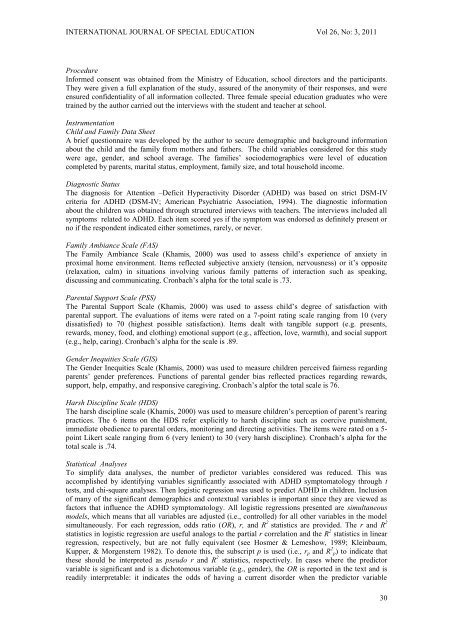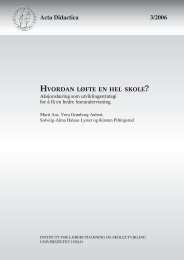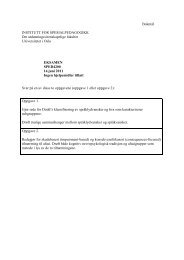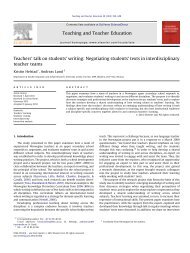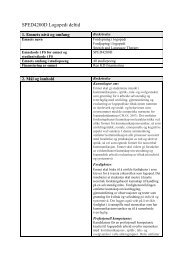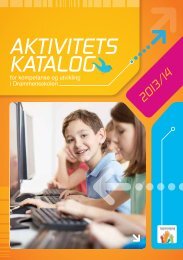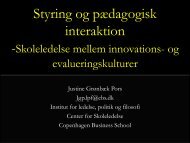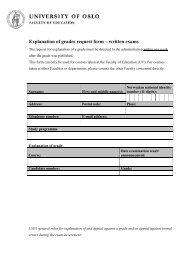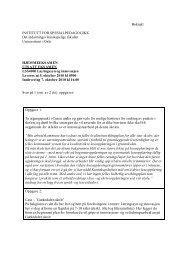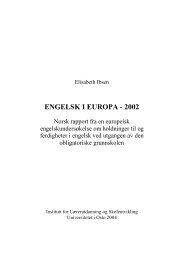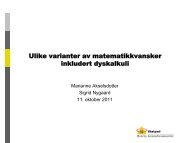International Journal Special Education
International Journal Special Education
International Journal Special Education
You also want an ePaper? Increase the reach of your titles
YUMPU automatically turns print PDFs into web optimized ePapers that Google loves.
INTERNATIONAL JOURNAL OF SPECIAL EDUCATION Vol 26, No: 3, 2011ProcedureInformed consent was obtained from the Ministry of <strong>Education</strong>, school directors and the participants.They were given a full explanation of the study, assured of the anonymity of their responses, and wereensured confidentiality of all information collected. Three female special education graduates who weretrained by the author carried out the interviews with the student and teacher at school.InstrumentationChild and Family Data SheetA brief questionnaire was developed by the author to secure demographic and background informationabout the child and the family from mothers and fathers. The child variables considered for this studywere age, gender, and school average. The families’ sociodemographics were level of educationcompleted by parents, marital status, employment, family size, and total household income.Diagnostic StatusThe diagnosis for Attention –Deficit Hyperactivity Disorder (ADHD) was based on strict DSM-IVcriteria for ADHD (DSM-IV; American Psychiatric Association, 1994). The diagnostic informationabout the children was obtained through structured interviews with teachers. The interviews included allsymptoms related to ADHD. Each item scored yes if the symptom was endorsed as definitely present orno if the respondent indicated either sometimes, rarely, or never.Family Ambiance Scale (FAS)The Family Ambiance Scale (Khamis, 2000) was used to assess child’s experience of anxiety inproximal home environment. Items reflected subjective anxiety (tension, nervousness) or it’s opposite(relaxation, calm) in situations involving various family patterns of interaction such as speaking,discussing and communicating. Cronbach’s alpha for the total scale is .73.Parental Support Scale (PSS)The Parental Support Scale (Khamis, 2000) was used to assess child’s degree of satisfaction withparental support. The evaluations of items were rated on a 7-point rating scale ranging from 10 (verydissatisfied) to 70 (highest possible satisfaction). Items dealt with tangible support (e.g. presents,rewards, money, food, and clothing) emotional support (e.g., affection, love, warmth), and social support(e.g., help, caring). Cronbach’s alpha for the scale is .89.Gender Inequities Scale (GIS)The Gender Inequities Scale (Khamis, 2000) was used to measure children perceived fairness regardingparents’ gender preferences. Functions of parental gender bias reflected practices regarding rewards,support, help, empathy, and responsive caregiving. Cronbach’s alpfor the total scale is 76.Harsh Discipline Scale (HDS)The harsh discipline scale (Khamis, 2000) was used to measure children’s perception of parent’s rearingpractices. The 6 items on the HDS refer explicitly to harsh discipline such as coercive punishment,immediate obedience to parental orders, monitoring and directing activities. The items were rated on a 5-point Likert scale ranging from 6 (very lenient) to 30 (very harsh discipline). Cronbach’s alpha for thetotal scale is .74.Statistical AnalysesTo simplify data analyses, the number of predictor variables considered was reduced. This wasaccomplished by identifying variables significantly associated with ADHD symptomatology through ttests, and chi-square analyses. Then logistic regression was used to predict ADHD in children. Inclusionof many of the significant demographics and contextual variables is important since they are viewed asfactors that influence the ADHD symptomatology. All logistic regressions presented are simultaneousmodels, which means that all variables are adjusted (i.e., controlled) for all other variables in the modelsimultaneously. For each regression, odds ratio (OR), r, and R 2 statistics are provided. The r and R 2statistics in logistic regression are useful analogs to the partial r correlation and the R 2 statistics in linearregression, respectively, but are not fully equivalent (see Hosmer & Lemeshow, 1989; Kleinbaum,Kupper, & Morgenstern 1982). To denote this, the subscript p is used (i.e., r p and R 2 p) to indicate thatthese should be interpreted as pseudo r and R 2 statistics, respectively. In cases where the predictorvariable is significant and is a dichotomous variable (e.g., gender), the OR is reported in the text and isreadily interpretable: it indicates the odds of having a current disorder when the predictor variable30


